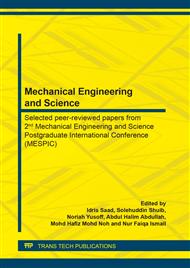p.50
p.61
p.73
p.81
p.94
p.103
p.117
p.126
p.135
Three-Dimensional Modeling and Finite Element Analysis of an Ankle External Fixator
Abstract:
External fixator has played an important role in repairing fractured ankle bone. This surgery is done due to the several factors which are the bone is not normal position or has broken into several pieces. The external fixator will help the broken bone to grow and remodel back to the original appearance. However, there are some issues regarding to the stability of this fixation. Improper design and material are the major factor that decreased the stability since it is related to the deformation of the external fixator to hold the bone fracture area. This study aims to design a stable structure for constructing delta frame ankle external fixator to increase the stability of the fixation. There are two designs of external fixator with two types of material used in this present study. Both external fixators with different materials are analyzed in terms of von Mises stress and deformation by using a conventional Finite Element Analysis software; ANSYS Workbench V15. The result obtained shows the Model 1 with stainless steel has less stress and deformation distributions compared to the Model 2. Hence, by using Model 1 as the external fixator, the stability of the fixation can be increased.
Info:
Periodical:
Pages:
94-102
Citation:
Online since:
June 2020
Keywords:
Price:
Сopyright:
© 2020 Trans Tech Publications Ltd. All Rights Reserved
Share:
Citation:


